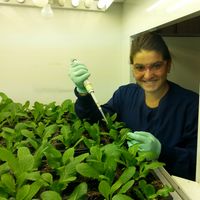Winter Vomiting Disease
Human norovirus was originally called Norwalk virus after the town of Norwalk, OH where the first confirmed outbreak occurred in 1972. The virus is a leading cause of foodborne illness worldwide. Human norovirus may be spread by food, water, person-to-person contact, or even by aerosolized vomitus droplets.
Noroviruses cause 19 to 21 million cases of acute gastroenteritis in the United States each year. Much like the flu virus, it is more likely to cause outbreaks in the winter season which is why it is also known as winter vomiting disease. Credit: Annies Home
Because the virus is highly contagious, it is known to cause outbreaks where large numbers of people are confined to smaller spaces such as cruise ships, college dormitories, hotels, resorts, and nursing homes. It is estimated that only 18 virus particles are necessary to induce illness involving symptoms such as diarrhea, vomiting, nausea, fever, and fatigue, indicating that even a small amount of contamination has the potential to be a public health threat.
Noroviruses do not respond to antibiotics or antivirals however; symptoms in healthy adults typically resolve within 1-3 days. Most people will describe a norovirus infection as having a “stomach bug” or “food poisoning” for which they do not go to the doctor. Complications may develop in young children, the elderly, or other immunocompromised individuals.
Due to the high incidence of the disease, difficulty of testing, and difficulty of surveillance it is crucial that prevention be a high public health priority. It is recommended that appropriate hand washing technique using warm water and soap be implemented regularly, especially after going to the bathroom, changing a baby’s diaper, or before preparing food. It is important to remember that alcohol based sanitizers are not as effective as using soap and water to remove bacteria and viruses from the hands.
Contaminated food is one of the most common vehicles associated with the spread of norovirus. Foods most commonly associated with outbreaks include shellfish, fresh fruits, and vegetables. In fact, noroviruses account for 60 % of all leafy green associated foodborne outbreaks and are the number one cause of foodborne outbreaks related to leafy greens such as lettuce and spinach. It is recommended that fruits and vegetables be thoroughly washed and shellfish thoroughly cooked prior to consumption.
Sources: WebMD, Foodborne Pathogens and Disease









